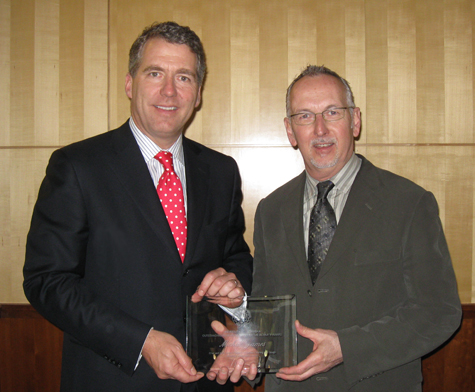
Professor Michael James wins system-wide ORCA award
01 May 2009
 University of Nebraska President J. B. Milliken presents the Outstanding Research and Creative Activity Award to TCD Chair Michael James
University of Nebraska President J. B. Milliken presents the Outstanding Research and Creative Activity Award to TCD Chair Michael James
Department Chair and Professor Michael James was selected as the winner of the 2009 University of Nebraska Outstanding Research and Creative Activity Award. A NU system-wide award, the ORCA was created to honor faculty who have brought distinction to themselves and to the institution as a result of widespread impact and recognition for their research. It is the highest recognition offered by the university for attainments in research and creative activity. Professor James and other 2009 award winners were presented with citations at the annual University Honors Convocation held on April 26 at the Lied Center for the Performing Arts, and with them was fêted at an awards luncheon on Wednesday April 29 at the Champions Club on UNL’s main campus.
James was cited for his artwork that has “garnered international prominence” and for his incorporation of advanced digital technology into his work, as well as for his stature as one of the world’s leading quilt artists. His work is included in the collections of the Smithsonian Institution’s National Museum of American Art in Washington, the Museum of Arts and Design in New York City, the Newark Museum of Art in New Jersey, the Indianapolis Museum of Art, the Mint Museum of Craft and Design in Charlotte, NC, the Racine Art Museum in Wisconsin, the Museum of Nebraska Art in Kearney, and the International Quilt Study Center & Museum here at UNL. In addition to serving as department chair, James currently teaches courses in the textile history/quilt studies program and participates in the collaborative Visual Literacy foundations program.
 Michael James' A Narrative of Space, of Time 2, a 2008 work evoking the intersections of cultures in the settlement of the Great Plains. Private collection.
Michael James' A Narrative of Space, of Time 2, a 2008 work evoking the intersections of cultures in the settlement of the Great Plains. Private collection.
Speaking about his studio work James said: “It’s true that having jettisoned their traditional functions as bed covers, quilts such as mine stand more squarely in the world of fine art than they do in the world of the applied arts. I think of them as bridging or straddling different but related domains of visual practice, helping to break down divisions and leading to a more inclusive view of what art practice can be in the 21st century.”
Textiles, Merchandising & Fashion Design